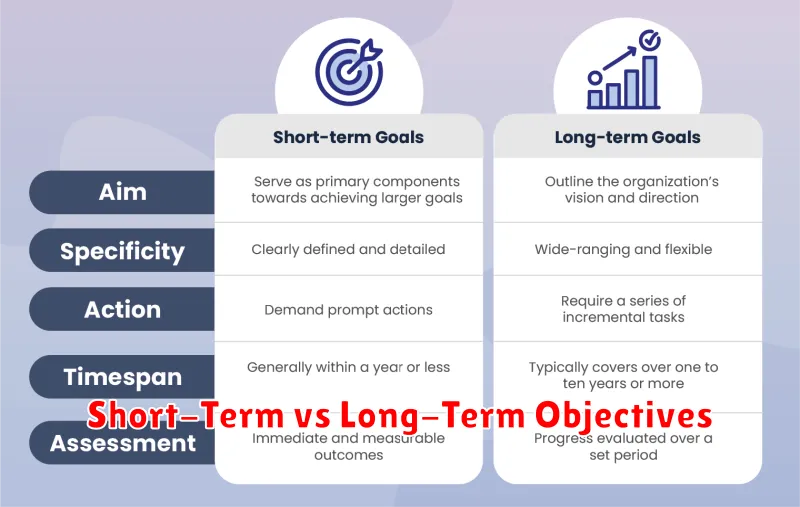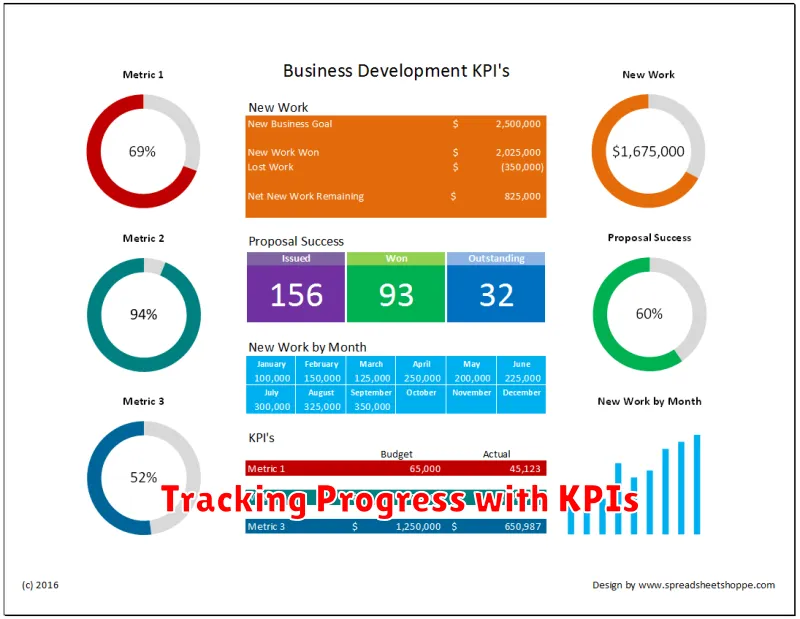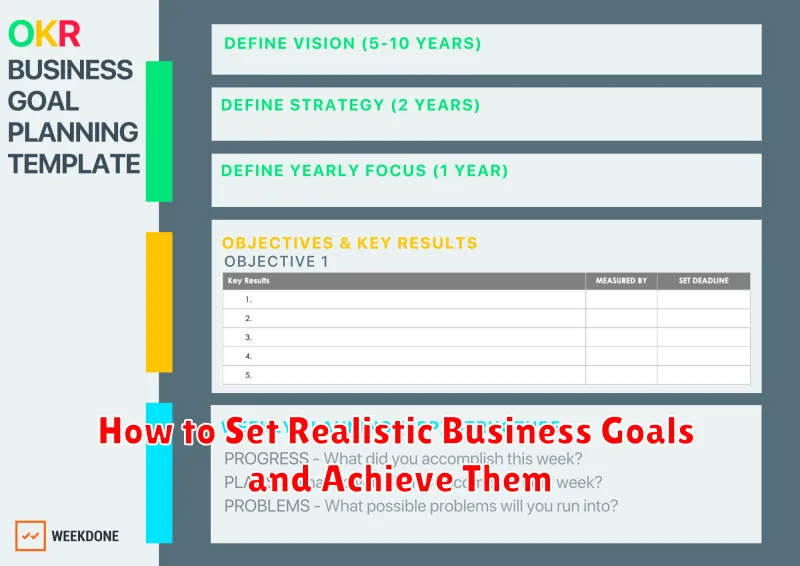Setting realistic business goals is paramount to the success of any venture. Whether you’re a seasoned entrepreneur or just starting out, clearly defined and attainable objectives provide a roadmap for business growth and achievement. This article will guide you through the process of setting realistic business goals that align with your overall business strategy and provide practical steps on how to achieve them. Learn how to effectively measure your progress, adapt to changing market conditions, and ultimately propel your business forward. Mastering the art of goal setting is essential for business success, fostering motivation, and driving sustainable growth.
From defining SMART goals (Specific, Measurable, Achievable, Relevant, and Time-bound) to crafting effective action plans, this guide provides the tools and insights you need to transform your ambitions into tangible results. Discover the importance of regular progress evaluation, adapting to unexpected challenges, and celebrating milestones along the way. By implementing the strategies outlined in this article, you can create a powerful framework for achieving business goals, maximizing your potential, and building a thriving and resilient business. Learn how to set realistic business goals and transform your vision into a reality.
Why Goal Setting Is Key to Growth
Goal setting is a critical aspect of business growth. It provides a roadmap for success, aligning efforts and resources towards desired outcomes. Without clear objectives, businesses risk stagnation and inefficiency, wasting valuable resources and missing opportunities for expansion.
Establishing specific, measurable, achievable, relevant, and time-bound (SMART) goals allows businesses to track progress and measure success effectively. This process fosters accountability and motivates teams to perform at their best.
Key benefits of goal setting include:
- Enhanced Focus: Clear goals provide direction and focus, ensuring everyone works towards a common purpose.
- Increased Productivity: Defined objectives promote efficiency and optimize resource allocation.
- Improved Motivation: Attainable goals boost morale and encourage teams to strive for excellence.
- Better Decision-Making: Well-defined goals inform strategic decisions and prioritize actions effectively.
Setting SMART Goals
A crucial aspect of setting realistic business goals involves using the SMART framework. SMART is an acronym that stands for Specific, Measurable, Achievable, Relevant, and Time-bound. This framework provides a structured approach to goal setting, increasing the likelihood of success.
Specific: Clearly define your goal. Avoid vague language. Ask yourself: What exactly needs to be accomplished?
Measurable: Establish metrics to track progress and determine success. How will you quantify your achievements?
Achievable: Ensure your goal is challenging yet attainable within your available resources and constraints. Is this goal realistic?
Relevant: Align your goal with your overall business objectives. Does this goal contribute to the broader vision?
Time-bound: Set a deadline for achieving your goal. By when should this goal be completed?
Short-Term vs Long-Term Objectives

Understanding the difference between short-term and long-term objectives is crucial for effective business planning. Short-term objectives are milestones achieved within a relatively short timeframe, typically within a year. These objectives act as stepping stones towards achieving larger goals. They provide a sense of immediate progress and contribute to maintaining motivation.
Long-term objectives, on the other hand, represent the overall, overarching aims of the business. These are typically achieved over several years, often three to five, and sometimes even longer. They define the desired future state of the business and provide a strategic direction.
Aligning short-term objectives with long-term objectives ensures that daily activities contribute to the overall strategic vision. For example, a long-term objective might be to increase market share by 20% in five years. Supporting short-term objectives could include launching a new product within the next year or implementing a marketing campaign within six months.
Tracking Progress with KPIs

Key Performance Indicators (KPIs) are quantifiable metrics used to track and evaluate the success of an organization, employee, or specific activity in meeting its goals. Selecting the right KPIs is crucial for effective progress monitoring. Choose KPIs that directly align with your business goals and are measurable, attainable, relevant, and time-bound (SMART).
Regularly monitoring KPIs provides valuable insights into your performance. This allows you to identify what’s working, what’s not, and where adjustments are needed. Consistent tracking enables you to make informed decisions, stay on track, and ultimately achieve your business objectives.
Some common examples of KPIs include:
- Revenue Growth: Tracks the increase in revenue over a specified period.
- Customer Acquisition Cost (CAC): Measures the cost of acquiring a new customer.
- Customer Lifetime Value (CLTV): Predicts the net profit attributed to the entire future relationship with a customer.
- Conversion Rate: Calculates the percentage of visitors or leads that complete a desired action.
Adjusting Plans When Needed
In the dynamic business landscape, rigidity can be a detriment. While a well-defined plan is crucial, adaptability is equally important. Market conditions shift, unforeseen challenges arise, and internal factors can evolve. Recognizing the need to adjust plans is a sign of strategic thinking, not failure.
Regularly review your progress. Establish key performance indicators (KPIs) and monitor them closely. If results deviate significantly from projections, investigate the underlying causes. Are your initial assumptions still valid? Has the competitive landscape changed? Honest assessment allows for timely course correction.
When adjustments are necessary, focus on maintaining alignment with your overarching goals. Amendments should not constitute a complete overhaul, but rather targeted modifications to keep you on track. Document the changes made, the rationale behind them, and the anticipated impact.
Celebrating Small Wins Along the Way
While focusing on the big picture is crucial for long-term success, acknowledging and celebrating small wins is equally important. These small victories contribute significantly to maintaining motivation and momentum throughout your journey.
Each small win validates your efforts and reinforces positive behaviors. This positive reinforcement helps create a cycle of success, encouraging you to continue striving towards your larger goals.
Consider implementing a system for tracking and celebrating these milestones. This could involve:
- Regularly reviewing progress: Schedule time to assess how far you’ve come.
- Acknowledging achievements: Verbally recognize your team’s accomplishments.
- Small rewards: Implement a system of small incentives for reaching milestones.
By acknowledging and celebrating small wins, you cultivate a positive and productive work environment, boosting morale and fostering a sense of accomplishment.

